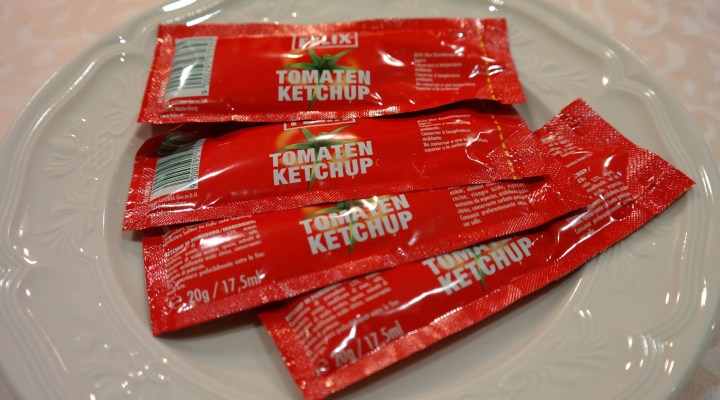
Why are ketchup packets so… unsatisfying?
The H.J. Heinz Company says it sells about 11 billion of its nine gram ketchup packets every year.
We were directed to examine ketchup packets by Marketplace listener Kali den Heijer for the latest installment of our series, “I’ve Always Wondered.” Den Heijer asked: “I’ve always wondered how they decided to make ketchup packets the size that they are.”
Because, of course, one is never enough.
Which is only one of many problems, author Rich Cohen points out. “You can’t open them, and you gotta use your teeth, and you squeeze it out, and you never get enough, and it gets all over your hands,” he says. “Also, once in a while somebody drops one of those things, and you step on it square. And you ruin someone’s day.”
In other words, there’s a bigger question here: Why are ketchup packets so awful? Cohen thinks his Grandpa Ben played a role.
Ben Eisenstadt ran a diner across from the Brooklyn Naval Yard in the 1930s and 40s. It boomed during World War II, then went bust when all the sailors went home. Time for a new business.
“And he had this idea that he should package tea,” Cohen says.
Eisenstadt worked in a tea-packing plant as a kid, and knew how the machines worked. He bought a machine to make tea bags, installed it in the empty diner and quickly found that this had been a terrible idea. Too much competition.
“So he didn’t know what to do,” Cohen says. “He’s sort of out of money, completely out of ideas. And he goes out to a meal, at Cookie’s in Brooklyn, with my Grandma Betty. And he’s like ‘What am I gonna do? What am I gonna do?’ And she says, ‘Why don’t you package sugar?'”
She had worked with Ben in the diner, cleaning up the bowls people had dipped spoons into. Gross. Eisenstadt re-configured the tea bag machine to make sugar packets. It was the first modern food-service packet. Later, he packaged other things: duck sauce, soy sauce. (Still later, he invented the artificial sweetener Sweet and Low and became rich, a story Cohen tells in his book “Sweet and Low: A Family Story.”)
Choen’s theory: “The Platonic form of all the packets is that original tea-bagging machine, turned into a sugar machine, in the Cumberland Diner.”
People who have worked in the food-service-packet-engineering world for decades say this is as good a theory as any. They confirm Eisenstadt invented the sugar packet, and that was the first one. The size could be a remnant.
Descendants of Grandpa Ben’s tea-bag machine now churn out up to 8,000 ketchup packets a minute in the Red Gold factory near Indianapolis. Red Gold has packed tomatoes since 1942. Later, the company expanded into ketchup.
Dave Halt came in 17 years ago to help crack the food-service market. He asked customers what they wanted.
“It became very clear that they wanted to buy their ketchup packets in a particular size,” Halt says. “[I] still haven’t quite figured out how they decided that nine grams is the size that was needed.”
Red Gold offers seven- and 11-gram packets, but there’s very little demand.
Cost is another consideration: Keeping moisture and oxygen from getting in, and keeping highly-acidic ketchup from eating its way out isn’t easy, or cheap.
“The actual cost of the package is really more than the nine grams of ketchup that’s inside,” Halt says.
It’s not that nobody has tried to design a better ketchup packet.
“There was a time when McDonald’s was hiring every designer under the sun,” says Jeremy Alexis. He worked for one of those design firms. This was about 12 years ago. McDonald’s wanted innovation and improvements.
So, the way designers do, Jeremy and the others spent a lot of time observing exactly how people used McDonald’s products. That meant riding around with moms-on-the-go, getting drive-thru while they’re on the phone.
“And at the same time,” he says, “the kids would be yelling, ‘I want the food now! I need it now!’ So they’d be handing the food back all at the same time.”
Alexis and his colleagues brought a lot of new packet designs to McDonald’s leadership. He says it was “like lambs being led to the slaughter,” because the new packet would cost more. McDonald’s gives ketchup packets away; each one might cost a nickel, and this is a nickel and dime business.
Then in 2010, after years of effort, Heinz actually did introduce a new ketchup packet. The Dip and Squeeze was three times larger than typical packets and boasted an easier-to-use design.“Old ketchup packet heads for trash” the Wall Street Journal declared at the time.
Nope. The packet costs more than three times as much to make. Operators worry teenage clerks would still pass them out by the handful.
There’s a lot happening in the world. Through it all, Marketplace is here for you.
You rely on Marketplace to break down the world’s events and tell you how it affects you in a fact-based, approachable way. We rely on your financial support to keep making that possible.
Your donation today powers the independent journalism that you rely on. For just $5/month, you can help sustain Marketplace so we can keep reporting on the things that matter to you.












